The History of the Lipton Cup
The Legend Lives On
In 1905 the Ponsonby Cruising Club, established in 1901, elected the now Sir Thomas Lipton, Vice President of their club. In acknowledgement Sir Thomas sent the Club photographs of Shamrock I, II and III which still hang proudly in the foyer. In 1916 the club, aware that Sir Thomas had donated a World Cup Trophy for football asked why the club should not seek a trophy for their club. The Club duly wrote to Sir Thomas and with it sent a photograph of the committee standing in front of the Esplanade Hotel on the waterfront at Devonport.
There are several stories about how the Ponsonby Cruising Club became a recipient of one of Sir Thomas Lipton’s trophies. Suggestions are that he was led to believe that this grand building on the Devonport waterfront was the Ponsonby Club house. Was this a cunning ploy? Sir Thomas had been an Honorary member of the Club for 10 years and maybe part of it was that he recognised something of himself in the working-class membership of the club. Whatever his inspiration Sir Thomas was impressed and had an appropriate trophy made and dispatched. In a letter dated 29 April 1920 he offered the Ponsonby Cruising Club a silver cup that he had commissioned the “Goldsmiths and Silversmiths Co of Regent Street London” (makers of the Americas Cup) to produce according to:
“A special design which would be typical of New Zealand and also embodying the burgee of the PCC, its general character to be appropriate to yachting.”
He left the allocation of the competition for the cup to the Club but asked that it be competed for by a specific class. The Cup did not arrive until September 1920 but the Club must have been ecstatic when the magnificent trophy was received.
Sir Thomas Lipton became a benefactor of yachting around the world and in 1931 at the age of 81, he was made an Honorary Member of the Royal New Zealand Yacht Squadron.
Sir Thomas Lipton was a great supporter of yachting in New Zealand and several clubs and organisations were the beneficiaries of his generosity. One such trophy is:
The Lipton Cup Presented by Sir Thomas Lipton Bart K.C.V.O. to the Auckland Yacht and Boating Association for Annual Competition in the 14-foot one design X Class, 1923.
It became an Auckland Anniversary Regatta Trophy and was first won by Iona in 1925. It was last sailed for by the X Class in 1964.
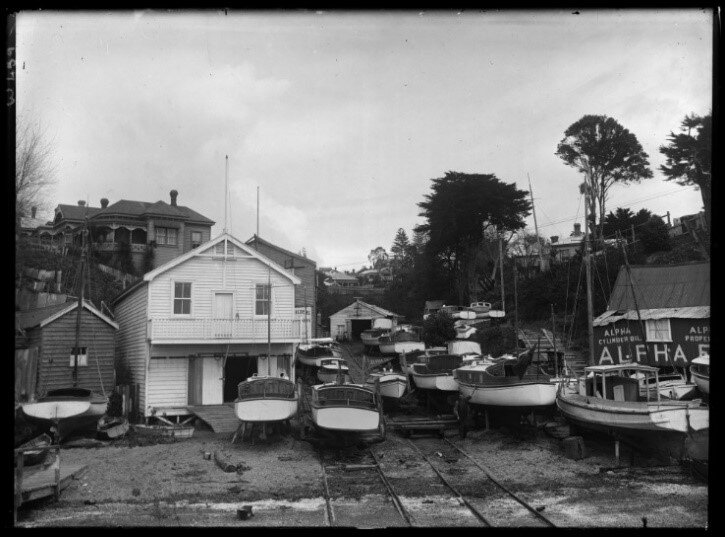
The Ponsonby Clubhouse in St Mary’s Bay, Ponsonby, as it was in 1914. To the right are Collings & Bell, Boat Building yards.
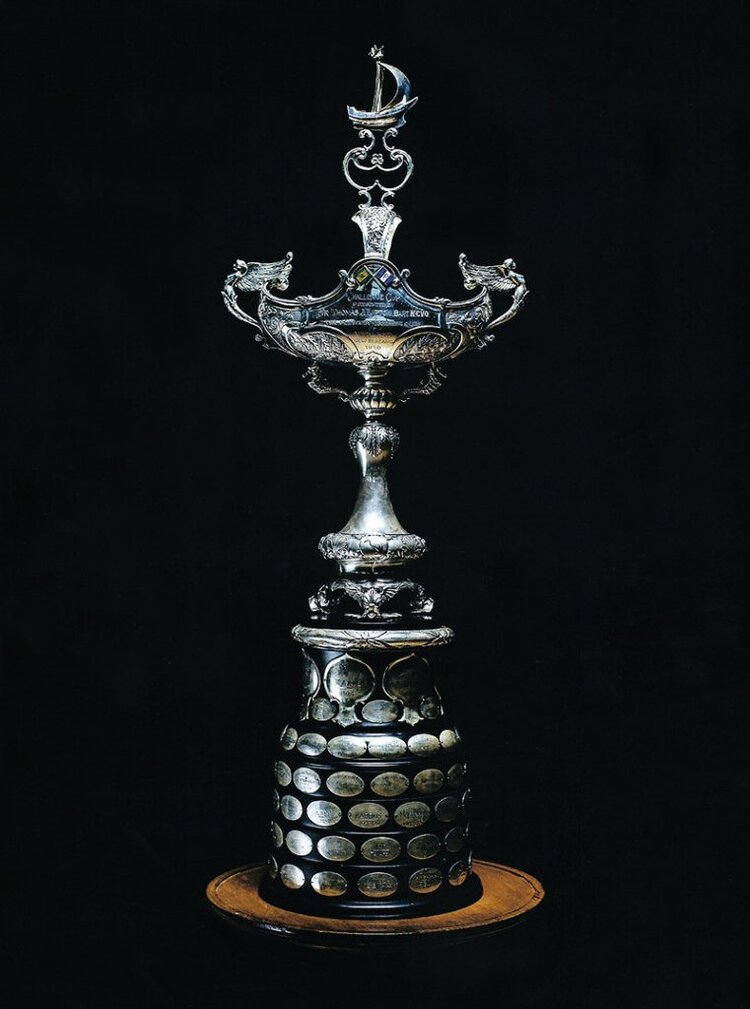
MULLET BOATS: FROM FISHING FLEET TO RACING CLASSICS:
“A 22-foot Shoal draft centreboarder with a daring bowsprit, an impossibly long main boom, a cloud-scraping spread of sails & class stalwarts who thrive on equal injections of history, speed, spills & thrills.”
From the 1860s small sailing vessels were used by the fishermen to bring home the mullet caught in the shallows of the Gulf. The early fishermen were both hard workers and capable sailors. By the 1880s it had become not uncommon for fishing boats to race competitively in the harbour or at sea especially on Regatta days.
In 1880 Auckland had a population of 20,000 people. The waters of the Harbour and Gulf teemed with fish and while a fleet of sail powered fishing craft worked the schools of snapper offshore a growing fleet of smaller craft were chasing the mullet in the shallows of the estuaries. After hauling aboard as much as a ton or more of mullet, the crew of two or three raced back to sell their fish by the wharves of Auckland. To distinguish them from their snapper fishing cousins this fleet was called the Mullet boats!
By 1885 the Mullet boat was a recognisable boat on Auckland’s waterfront. Mullet boats were open boats, straight stemmed, half decked to the mast with a cuddy forward for overnight shelter and cooking was done in half a 5-gallon paint tin. They carried 400 square feet of cotton sails on a high-peaked gaff rig with a long bowsprit. Hulls were planked Kauri with sawn Kauri frames and a broad vertical tuck over which they could haul the nets after removing the large barn door rudder. The centreboards of half inch boiler plate or bronze and the broad beam gave them stability and carrying capacity. The centrecase split the load of up to 40 dozen mullet for the windward beat home. A demand for the builders and designers of faster Mullet boats had developed and the first Mullet boat to be used solely for pleasure. Many of the skippers of the fishing Mullet boats were in demand as professional hands on Auckland racing keelers.
By the turn of the century, auxiliary engine-powered boats went fishing and Mullet boats came into their own as pleasure and racing yachts. From the early 1900s, Mullet boats were being designed by prominent people like the Baileys, Logans and Collings, specifically for competitive racing. The Mullet boat soon became the highest profile racing boat on the harbour with up to 70 Mullet boats in the five classes from 18 to 26 feet racing regularly.
In 1905, the Ponsonby Cruising Club was encouraged to draw up a set of rules and restrictions to maintain some uniformity in the various shapes and sizes.Four classes were decided on:- N class 20ft, L class 22ft, I Class 24ft and H class 26ftThe Ponsonby Cruising Club has remained the administrator of the class.By 1915, the large shoals of mullet had almost been depleted and fishermen were turning to line and oyster fishing and petrol engine launches. Some Mullet boats were derigged and converted to power boats but class racing had developed in Auckland and the Mullet boats had developed into one of the strongest fleets on the harbour.
On 8 April, 1922 the 22-foot L Class Mullet Boat fleet was chosen to race for the Inaugural Lipton Cup event to be held by the Ponsonby Cruising Club over a harbour course.
At that time about 15 boats were racing regularly at the club making it the most popular class racing. At a meeting on September 28, 1922 it was decided to settle the premium Insurance of £1:10/-, the current holder of the trophy was to pay – Victoria Cruising Club, as the first winners were to pay the first year’s premium.
Now days the LIPTON CUP stands proudly in a glass cabinet at the head of the stairs in the club house safely under lock except on special occasions. On LIPTON CUP Day it is presented to the winning crew before being returned to its glass cabinet and re-emerging again for the Annual Prize Giving. The LIPTON CUP race has since been a hotly contested Annual Interclub Challenge sailed in the same class every year, the Mullet Boats, administered by the Ponsonby Cruising Club, without a miss, since 1922! On one occasion, in the 1940s:
“All sailing on the harbour was cancelled because of the stormy weather - EXCEPT the LIPTON CUP!” - These proud little vessels just reefed their mains and sailed through!The L Class Rules have remained basically the same as first set out in 1913 – boats built over the century still comply and can still be competitive. The Club and the Lipton Cup have served to preserve this historic class and are the reason the L Class yachts still race regularly and will compete in the Centennial Sailing of the Lipton Cup in 2021. The Lipton Cup is the oldest trophy still raced for annually in New Zealand by the same class sailing under the same basic rules.Lipton Cup Race No. 1 was sailed on the 8th April, 1922. The Start time was 2.30 p.m.The elapsed time for the first boat was 3 hours 44 minutes.In March 2021, the Ponsonby Cruising Club will proudly celebrate the 100th sailing of this prestigious event – the 100th race for the LIPTON CUP.2021 is a significant year for Auckland, the City of Sails! For the first time the challenges for both the AMERICA’S CUP and the LIPTON CUP, two magnificent trophies proudly displayed by two senior clubs on the Westavhen reclamation, will take place on the waters of the Waitamata Harbour in boats designed and separated by over 100 years of Kiwi innovation.
In 1951, in the August edition of SEA SPRAY, “Speedwell”, a regular reporter of yachting and boating activities, reluctantly admitted the decline of the L Class Mullet Boats, their place being taken by the more popular short end keelers. A factor of the decline, to quote “Speedwell”, W.A. Wilkinson:“Was the enormous sail area and the overhanging booms and the usual need for a crew of six or more!”“But every dog has its day and the mullet boats have had theirs! They will never completely die out as long as our present-day skippers can hold a tiller. Good luck to them from one of their oldest admirers.”W.A. Wilkinson!
Fifty years on and we are celebrating this noble class with the Centennial of LIPTON CUP!
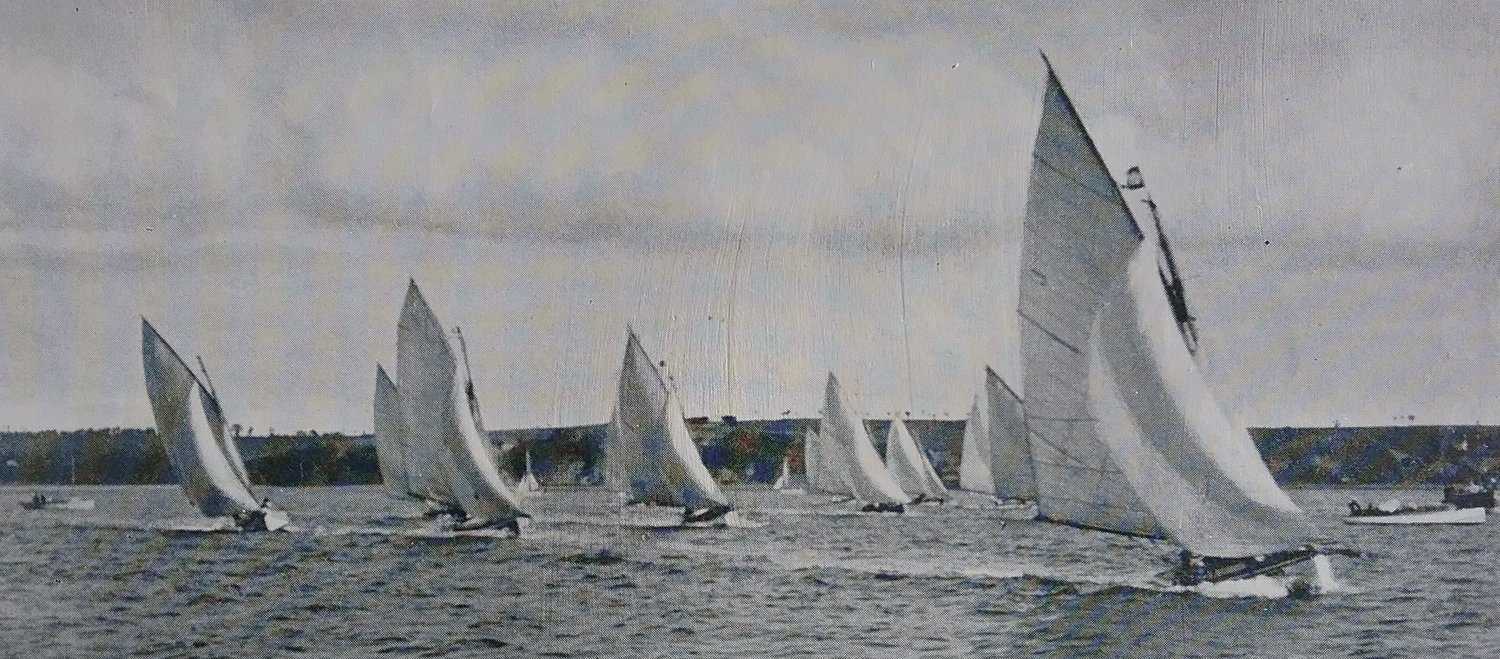
PONSONBY CRUISING CLUB, 10 April 1922: VALERIA WINS FIRST RACE FOR THE LIPTON CUP
The Ponsonby Cruising Club held races for yachts and launches on Saturday afternoon. A good sailing breeze from the north was blowing in the early part of the afternoon but later in the day the wind shifted to the north-east and fell rather light.
The most important event on the programme was the challenge race for the Lipton Cup. This race which was confined to the 22ft class, brought out six competitors, each being nominated by a yacht club. The race caused considerable interest, and was won by the Valeria nominated by the Victoria Cruising Club. The cup will be handed over to that body, which will retain it until its title is challenged, races being held annually.
The officials in charge of the racing were: Starter Mr. H.H Arthur, Timekeeper Mr A. Craig, Judge Mr. W. Joynt.
The challengers were Marie, Forest Gold, Venus, Lucille and Mowai. Marie got the best of the start crossing the line about a length ahead of Forest Gold and Valeria. Venus was 35s late, Mowai 50s and Lucille 2m 13s late. Marie continued her lead until off the dock where Valeria, which was pointing much higher than Marie, assumed the lead.
The wind was now very light and the boats made slow progress to the Sandspit beacon. Valeria as still in the lead when this mark was reached rounding it about 1m ahead of Maria and Venus these last two boats making the turn on almost level terms. Forest Gold was next round and then came Mowai and Lucille. On the run up the harbour Marie and Venus made a very close race of it and were still fighting it out on level terms when they passed the flagship for the first time up to the top mark. The times at this stage were: Valeria 3h 59m, Venus 4h 2m 48s, Marie 4h 2m 48s, Mowai 4h 8m 12s, Forest Gold 4h 12m 55s, Lucille 4h 15m 23s.
After rounding the top mark at the Watchman, Valeria worked the northern shore, Venus kept in about mid-channel while Marie stood along the southern shore. There was very little between the last two boats until Queen’s Wharf where Marie got the benefit of a change of wind which enable her to draw away from Venus. Meanwhile Lucille gave up. The run up the harbour for the second time saw Valeria still in the lead with Marie and Venus following in that order.
The finishing times were: Valeria 6h 14m 44s, Marie 6h 15m, Venus 6h 24m 33s, Forest Gold 6h 27m 54s, Mowai 6h 32m 5s.
HERNE BAY CENTREBOARD CUP - 19 DECEMBER, 2020:
Eighty years on and this was a significant event in the lead up to the Centennial Regatta for the Lipton Cup to be sailed March 20, 2021. Eighty years ago, L25 Otira representing the Herne Bay junior Yacht Club won this noble trophy! Sailing on that day were L7 Komuri and L28 Melita.
The race on Saturday started off the old Herne Bay Yacht Club building at Sloanes Beach (the original home of the Richmond Yacht Club) in a very light northerly with flat seas. From the start it was round Watchman Island to port, Chelsea Buoy to port, the start mark to port, twice round.
After a very close but “gentle” start in the light breeze L52 Rangi Manu found clear air and took off to lead L7 Komuri round the Watchman Is while L28 Melita and H5 Nomad kept close company further astern and that was the order in which they finished.
A great day and a curtain raiser for the Centenary in March when both Melita and Komuri will again be racing, with Rangi Manu, for the Lipton Cup.
L7 Komuri, H5 Nomad, L28 Melita & L52 Rangi Manu (Obscured) on the start line.
Then it was home to watch the Prada World Series in which those other “extreme” boats with their foils raced each other in a lead up event to the Americas Cup also to be sailed in March 2021.
Unlike those boats, and with no foils and with their “extreme” sail areas, the Mullet boats just kept sailing in those variable light airs.The foiling fleet “touched down” and stopped!
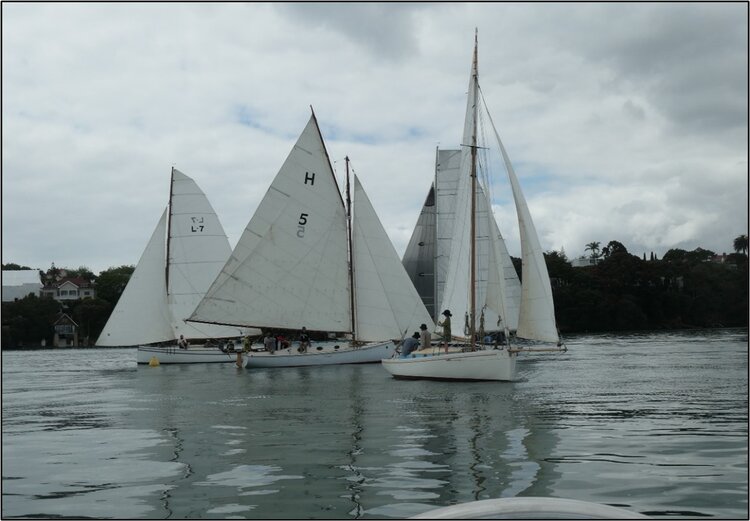
L7 Komuri, H5 Nomad, L28 Melita & L52 Rangi Manu (Obscured) on the start line.
AND EIGHTY YEARS AGO: 20TH LIPTON CUP: 25 January, 1941
From Papers Past: The NZ Herald.
Chief interest in tomorrow’s yachting will centre in the annual Lipton Cup contest under the control of the Ponsonby Cruising Club and starting and finishing off the Victoria Cruising Club’s new clubhouse on the St Mary’s Bay reclamation. This valuable trophy has caused keen competition among the 22ft L Class. In spite of war conditions there is an increase of two entries on those of last year. In addition, the Ponsonby Cruising Club will hold its annual cup day for all classes below the keelers which will be catered for by the Royal New Zealand Yacht Squadron. The Panmure Boating Club will hold races on the Tamaki River while on Sunday the Kohimarama Club will decide its usual handicap race off the Kohimarama Wharf.The boats nominated are: L7 Komuri Victoria Cruising Club, L21 Marika Royal Akarana Yacht Club, L26 Varuna Takapuna Boating Club, L25 Otira Herne Bay Junior Yacht Club, L28 Melita Whangarei Cruising Club, L31 Valkyria Richmond Yacht Club, L32 Varmarie Tamaki Yacht Club, L34 Zamira Otahuhu Sailing Club, L13 Celeste Manukau Yacht Club, L2 Marie Ponsonby Cruising Club, L10 Venus Point Chevalier Sailing Club.
27 January, 1941 LIPTON CUP CONTEST SUCCESS OF OTIRA
Sailed under ideal conditions, the 20th annual contest for Auckland's leading yachting trophy, the Lipton Cup, resulted in a win for L25 Otira, owned by Messrs. G. Bourke, A. Wratten and R. Brummel, and sailed by V. Riley, the former owner and a previous Lipton Cup winner with L18 Rakoa. Otira represented the Herne Bay Junior Yacht Club in the contest.The race started and finished off the new St. Mary's Bay reclamation and the course was from there to the Bastion, thence out to the White Light buoy in Rangitoto Channel, and thence back to the Bastion and up to Rona buoy off Chelsea with a short leg to the finishing line. L7 Komuri and L21 Marika were too eager and had to return at the start, losing their windward positions. L28 Melita, the Whangarei Cruising Club representative, was first, away but had torn a reef point out, which soon opened into a split across the sail, and she retired before the fleet had passed the end of the boat harbour wall.
As they passed the Western Wall Marika was in the lead but down to leeward with Komuri and Otira working out to windward followed by L2 Marie, L32 Varmarie, L31 Valkyrie, L34 Zamira and L10 Venus. It was on the close haul to the Bastion that Otira really won the race, by keeping out in the harbour and going to windward of an overseas boat, which enabled her to fetch the Bastion mark with eased sheets, seven seconds ahead of Marika, which had to pinch to keep up to windward to make it. Komuri, which also made the mark with eased sheets, was 58s further back.With the exception of Venus which threw round immediately she passed the mark, the fleet carried on before going about for the long beat out to the white light. Venus stood across toward Cheltenham Beach but did not gain the advantage as Valeria had done with by such tactics some years ago. Otira increased her lead, while Komuri sailed into second position and when they came back to Bastion Otira had a lead of 3m 27s from Komuri, with Marika and Zamira 43s and 44s respectively astern. On the lead up-harbour to the Rona buoy Komuri lessened the gap but could not catch Otira. Zamira passed Marika to get third.
The elapsed times for the course were: Otira (Heme Bay Junior Yacht Club) 2h 5m 28s; Komuri (Victoria Cruising Club), 2h 7m 46s; Zamira (Otahuhu Sailing Club) 2h 10m 2Is; Marika (Royal Akarana Yacht Club), 2h 10m 30s; Valkyrie (Richmond Yacht Club), 2h 11m 54s; Varmarie (Tamaki Yacht Club), 2h 15m 26s; Marie (Ponsonby Cruising Club), 2h 15m 35s. Venus (Point Chevalier Sailing Club) retired.
The Lipton Cup Results were: 1. Otira – Herne Bay Junior Yacht Club, 2. Komuri – Victoria Cruising Club, 3. Zamira – Otahuhu Sailing Club.(L34 Zamira became Ngahere in 1946 as she is still known and may join the Lipton Cup fleet for the Centennial in 2021!)
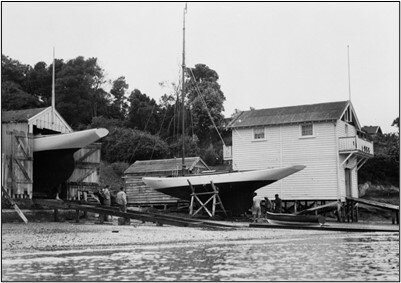
Herne Bay Yacht Club 1937 (Formerly Richmond Yacht Club)
 Admin Login
Admin Login